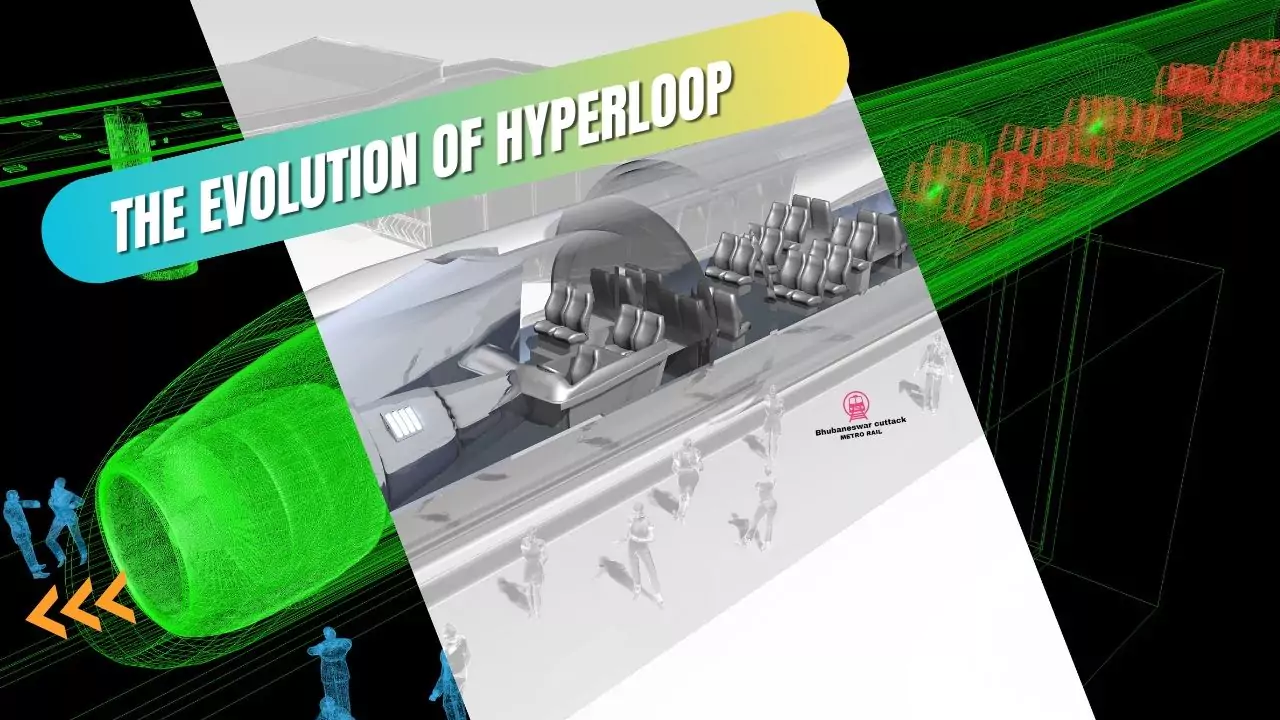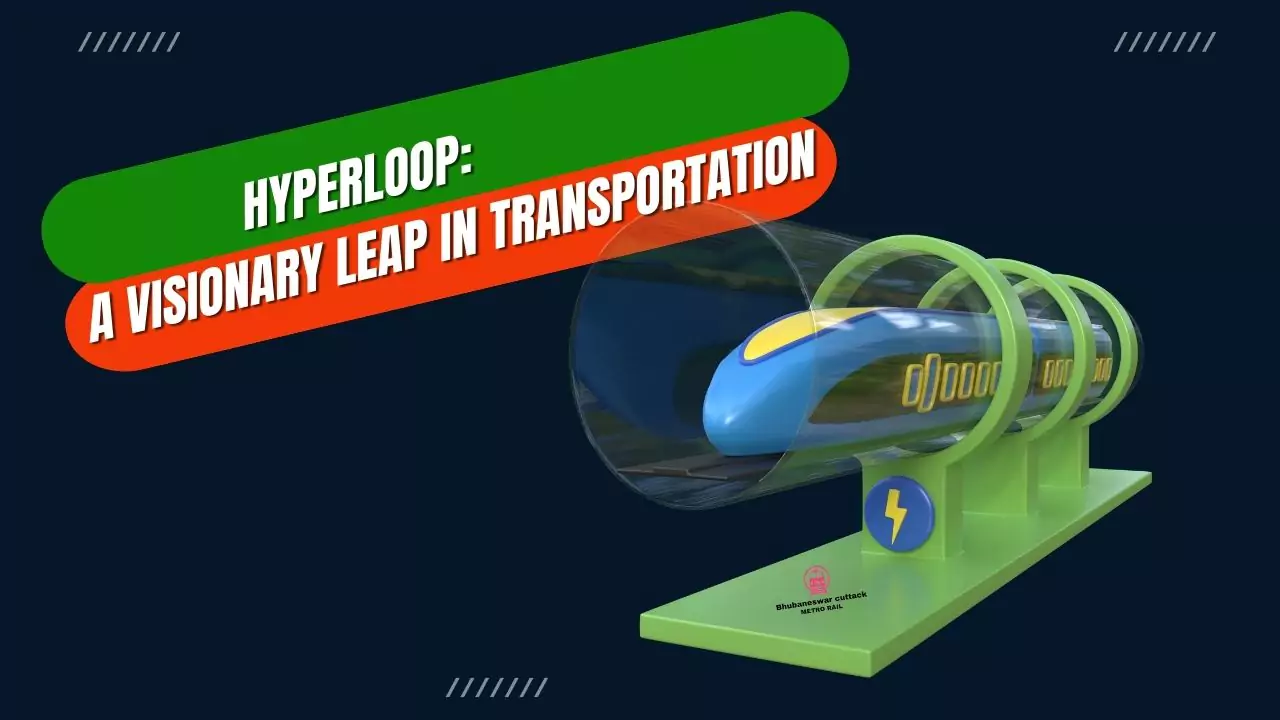What is Hyperloop transportation?
Hyperloop Transportation is a groundbreaking transportation concept designed to revolutionize travel by combining various engineering principles. At its core, the high-speed system comprises passenger pods traveling at high speeds through near-vacuum tubes using electric propulsion and magnetic levitation.
Hyperloop: A Visionary Leap in Transportation
Hyperloop Transportation India stands as an unprecedented advancement in transportation infrastructure, propelling passengers within pods at the speed of airliners through enclosed tubes utilizing electric propulsion and magnetic levitation. Its promise? Drastically slashing travel times between major cities from hours down to mere minutes.
Whilst it may feel like science fiction, hyperloop is now on the cusp of becoming a reality. This is the story behind the concept that’s about to revolutionize our world.

Conceived in 2012 by Elon Musk, the mastermind behind Tesla and SpaceX, the hyperloop vision emerged through a groundbreaking white paper released in the subsequent year. Musk’s blueprint envisioned a futuristic transportation system where passenger pods maneuver through steel tubes within a partial vacuum, directly addressing the major limitations of traditional vehicles—friction and air resistance.
Contemplating a potential route linking Los Angeles to San Francisco, Musk anticipated reducing the lengthy eight-hour bus journey, four-hour train ride, and convoluted three-hour air travel to a mere half-hour commute.
Musk’s initial hyperloop proposal suggested using compression fans to minimize drag and create “air bearings,” suspending the pods above the tube’s surface. Interestingly, Musk’s early concept shared similarities with Isambard Kingdom Brunel’s atmospheric railway, operational in the UK from 1847 to 1848, which propelled carriages using pressurized air extracted from pipes, creating a vacuum and pulling the train forward. Despite initial success, Brunel’s railway faced challenges due to failing airtight seals, leading to its abandonment.
Although Musk’s first hyperloop concept, estimated at close to USD 6 billion, never materialized, its visionary potential sparked widespread interest. Musk, advocating for an “open source” approach, inspired the formation of startups and student teams to independently develop hyperloop technology, leading to significant advancements by various companies.
Among these, Hyperloop Transportation Technologies (HTT) made significant strides, constructing a full-scale test track in France. However, leading the current race is Virgin Hyperloop One, originally established in 2014 and rebranded following a substantial investment by Sir Richard Branson in 2017.
Diverging slightly from Musk’s original plan, Virgin Hyperloop One integrates magnetic levitation (MagLev) technology, akin to monorails, to elevate and propel passenger pods along the rails.
The stage is set for Virgin Hyperloop One to realize its ambitious goal of implementing a functional hyperloop system by 2021, marking a monumental leap in transportation evolution.
The Impact and Potential of High-Speed
Magnetic levitation works like a futuristic dance of magnets—two sets create a spectacle. One set repels the train from the track, lifting it gracefully upwards, while the other set glides the train along at impressive speeds with minimal friction. Imagine a low-pressure, vacuum-sealed environment for passenger pods traveling through tubes, almost as if floating in air 200,000 feet above sea level.
This unique setup allows these pods to zip along at over 760 mph while sipping energy conservatively. Encased within tubes, the system is shielded from the elements, capable of operation in almost any weather conditions.
Virgin Hyperloop One has orchestrated a ballet of technology, steering its system with advanced software, ensuring a seamless journey for passengers. They’ve rigorously tested every component, from propulsion and braking to levitation and vacuum systems. Clocking over 240 mph, they’ve mastered the art of speed and efficiency.
Their vision extends beyond tests—a global challenge was launched to identify optimal routes for hyperloop technology. Out of thousands, 35 locations emerged as prime candidates, each with substantial backing from governments and urban planners. Collaborating with ten winning locations across five countries, Virgin high-speed One is now choreographing the implementation of this revolutionary technology.
In the realm of benefits, hyperloop stations—dubbed as portals—are designed to nestle within inner-city hubs, bridging transportation gaps with easy connectivity. Unlike airports on the outskirts, the hyperloop’s accessibility stands out. It’s envisioned as a hassle-free “turn up and go” experience, skipping lengthy check-ins for swift and robust security checks.
The standout perk? Speed. Imagine living in one city and working in another without a commute longer than what you might already have. Hyperloop’s potential to slash travel times between cities opens doors to diverse housing and job opportunities, easing the strain on crowded city centers and soaring housing prices.
With speeds matching aircraft and a focus on domestic routes, the hyperloop could rewrite the script of how we live, work, and travel, offering a transformative shift in our daily routines and urban dynamics.
Addressing Safety and Concerns
The marvel of a high-speed system lies in its minimal energy consumption, effortlessly propelling pods through tubes in a vacuum environment. This potential energy efficiency opens doors to a cleaner future, envisioning power sourced from renewable options like solar or wind, presenting a greener alternative to traditional air travel.
Yet, pondering the idea of hurtling across the earth’s surface at near supersonic speeds naturally conjures queries about safety. What if a tube breaks due to an earthquake or external impact? Virgin Hyperloop One has diligently countered this concern by fortifying the tubes with robust, thick steel, making breaches a near-impossible feat. Their engineering ensures the tubes can withstand pressure variations and air leaks without compromising their structural integrity.
Theoretically, should air suddenly infiltrate a tube, it’d modestly slow down the pods due to increased air resistance. But fear not! These pods possess the agility to reroute to the next portal with an added power boost if needed. Moreover, emergency exits are standard in all pods, and the system can isolate and re-pressurize segments in case of emergencies.
Externally, the hyperloop glides on raised, seismic-resistant pylons designed to flex independently, minimizing potential damage from ground shifts. Sensors vigilantly line the route, swiftly alerting the control center to any issues.
Addressing safety qualms, Virgin Hyperloop One rightly points out that millions already traverse in metal tubes during flights, reminiscent of early concerns about jet aircraft’s safety. The evolution of transportation technology over the past two centuries and the rapid strides made by hyperloop companies worldwide underscore the imminent integration of this extraordinary transportation system into our daily lives.
Here are the key components and aspects of hyperloop technology:
- Pods: Specialized passenger or cargo pods designed to travel through low-pressure tubes at incredibly high speeds. These pods aim to transport individuals or goods between destinations efficiently.
- Tubes: Long pressurized tubes that create a near-vacuum environment to minimize air resistance. These tubes are constructed to enable the pods to move at exceptionally high speeds with minimal friction.
- Electric Propulsion: Linear electric motors or other propulsion methods that propel the pods through the tubes, providing the necessary acceleration and maintaining high speeds.
- Magnetic Levitation (MagLev): Implementation of magnetic levitation technology to lift and propel the pods. Magnetic forces are utilized to both suspend the pods above the track and move them along their designated routes with minimal friction.
- Low-Pressure Environment: The tubes maintain a low-pressure environment, akin to flying at high altitudes, significantly reducing air resistance. This facilitates high-speed travel with minimal energy consumption.
- Control Systems: Advanced software and control mechanisms ensure the smooth operation of the system, managing pod acceleration, and deceleration, and maintaining safe distances between pods.
- Safety Features: Thick, durable tubes constructed to withstand external impacts, emergency exits in pods, earthquake-resistant pylons, and real-time monitoring systems ensure passenger safety and system resilience.
- Energy Efficiency: Hyperloop’s design aims for energy efficiency, utilizing minimal energy to propel the pods through the tubes, potentially powered by renewable energy sources like solar or wind power.
Hyperloop Transportation FAQs (Frequently Asked Questions):
Is Hyperloop safe?
Virgin Hyperloop One’s meticulous engineering and safety protocols prioritize passenger safety. Thick steel tubes, emergency exits, earthquake-resistant pylons, and real-time monitoring ensure system resilience and passenger security.
How does hyperloop compare to traditional transportation modes?
Hyperloop offers unparalleled speed, reduced travel times, inner-city accessibility, and minimal energy consumption compared to conventional modes like air travel, trains, or buses.
Can the hyperloop be powered sustainably?
Yes, the low-resistance vacuum environment allows for minimal energy consumption, aligning with renewable energy sources like solar and wind power, offering a cleaner alternative to air travel.
What happens in case of a tube breach or emergency?
Stringent safety measures include pod slowdown due to increased air resistance, redirection to the next portal with auxiliary power, sectioning off routes, and real-time monitoring for immediate responses to emergencies.
When can we expect Hyperloop to be operational?
Companies like Virgin Hyperloop One aim to achieve operational systems within the next few years, with prototypes and extensive tests already showcasing promising results, suggesting an imminent integration into daily life.
Conclusion:
The hyperloop embodies a transformative leap in transportation, promising unparalleled speed, efficiency, and accessibility. With visionary minds driving its development and significant technological advancements, the once-distant concept is on the verge of reshaping global travel. Its potential to redefine commuting, alleviate urban pressures, and propel sustainable transport solutions positions the hyperloop as a cornerstone of future societal evolution.

